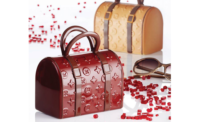In 2013, Annie Roggero and her son Virgilio Rubini were driving from Montreal, Canada to the Sweets and Snacks Expo in Chicago to exhibit products from their chocolate company ChocoStyle, which is famous for it’s high-end chocolate shoes.
They had samples and the booth in the car, but when they go to the border they hit a literal roadblock. Apparently some of their paperwork wasn’t quite right, and the customs agents wouldn’t let them into the U.S. So, they had to go back to Montreal, figure everything out, drive back to the border, get through and then continue on to Illinois.
What was normally a 17-hour drive had turned into a 34-hour day.
“It was terrible. You can’t imagine how many hours, and the stress,” recalls Roggero, founder of ChocoStyle.
When they finally got to the show, later than expected, they still had to set everything up and then work the show all week.
“The sweat and tears of just getting to the show, and then working the show, standing up, meeting everybody, just the sheer fact of work was stressful enough,” says Rubini, current president of ChocoStyle Int’l. “I’m glad to say that year was one of our good years though."
Indeed, they secured business with companies like the Burlington Coat Factory, a test run in It’Sugar and repeat business with Bed Bath & Beyond.
The whole thing is indicative of the work ethic and passion behind ChocoStyle, which is working to saturate the U.S. and international markets as a whole, one chocolate shoe at a time.
Technically the artisan company was born in 2005, after Roggero’s husband died. She was devestated by the loss and realized that she needed a change. So, she decided to study chocolate making, taking classes in Europe and it turned out to be just what she needed.
“I was very depressed and I decided to change careers and when I went to the [chocolate] school and I smelled chocolate, it reminds me of my grandmother and all that, because we come from a town where one of the best cocoa trees in the world, it’s called the white chocolate, the white cocoa bean in Peru, so it reminds me of my grandmother,” she recalls. “So I decided that’s what I was going to do, so I quit the job and went to France and I took classes everywhere around the world imaginable to start the company.”
Indeed, she was one of the first women ever to graduate from the Barry Callebaut Academy.
After studying the craft for five years, she decided to open her own shop out of the basement in her home in Montreal in 2000. Back then though, the company went by a more French name, Pour l'amour de Chocolate, which translates to For the Love of Chooclate.
Roggero was lucky because her house just happened to be in an area that was zoned for some commercial, so she could sell the chocolates she made out of her home without any issues.
Everything was going so well that in 2006-2007 she decided to expand and it just so happened that her son Rubini was coming back from Peru to live in Canada at that time, and he was able to help out.
They decided that one of the first steps to expanding the company was to go to the Fancy Food Show, but they didn’t want to bring a French company name to the U.S. show, so they changed it to I Love Chocolat.
“So I Love Chocolat was the name that we went to the Fancy Food show with in the Canadian pavilion and had an incredible reaction from buyers, including Costco, who came to the house to see where the chocolate was made,” Rubini recalls. “You can understand, it wasn’t a feasible arrangement, Costco buying from somebody making chocolate in its basement. And at that point there was a need to make more products, make it more viable, to get more to the consumers.”
So they decided to open up retail points, but luck was not on their side. This was 2007, and the crash in 2008 was about to hit them hard. And, they realized that running retail shops was entirely different than creating chocolates in Roggero’s basement.
“More than anything the retail points really took us down, because we went from being a manufacturer with one point retail to becoming a retailer and having to manage store hours, and staff,” Rubini says. “We were no longer focused on the chocolate, we were focused on selling retail and changing the prices and replacing the staff that didn’t come in and going to pick up the deposits and pay the employees and we just became much more of a retail business than actually a chocolate business.”
They also signed big leases and then were faced with the Great Recession. In the end, they realized that the only way out of it all was to sell Roggero’s house.
”So it was a really, really emotional and hard time,” Rubini says. “It was hard for her to sell her house. It was hard for her to stop creating. At that time it was so, so difficult. It was so emotional having to relearn what we want to do.”
But just like the issues at the border in 2013, this was not going to stop them.
“We are quick learners, we’re smart people and we’re go getters,” Rubini says. “We do not let obstacles stand in our way.”
They decided to refocus their attention on the product, with an eye toward corporate contracts. And they bought what has become their manufacturing facility in Montreal.
They also decided to change the name one more time — to ChocoStyle.
“We really had the need to come up with a name that catered to the French and to the English,” Rubini explains. “It was play on words because with the product, everybody kept saying, oh, it’s so beautiful.”
And they focused on what the company has since become famous for — chocolate fashion.
“ChocoStyle itself comes from the idea of focusing on what people love best,” Rubini says. “So we asked ourselves, ‘Who likes chocolate? Men or Women? Mostly women.’ Then, ‘What else do women like?’ And we said, ‘Fashion. And what in fashion? Fashion is too vague. So shoes.’ It was just something that emotionally connects.”
Now they create chocolate purses, chocolate lipsticks and even chocolate cowboy boots.
By the end of 2011, they were seeing some success with their new strategy, but they wanted to expand beyond the relatively small Canadian market. And in 2012 they decided that it was time for Rubini to officially take over the company.
“Annie can turn around and do her passion, which is teaching and developing and creating,” Rubini says. “It doesn’t have to be on a daily routine of just making the same product over and over because that killed her a little bit.”
It was around this same time that Rubini also decided that the company should diversity, and he created Axenta, the distribution arm of a variety of companies, mainly that deal in the confectionery gift segment. The company helps smaller manufacturers navigate the North American market, working as a confectionery designer, manufacturer, distributor and agent.
“[We help] companies who do not speak the language, or have issues with speaking the language, who cannot be at every trade show, who do not have the experience of dealing with the broker network or reps, who don’t have the background or the resources to deal with the exit strategies or square feet charges or every detail that retailers are now putting into play in order for us to do business with them,” Rubini says.
The company helps confectionery manufacturers navigate everything from price points to dealing with multiple distribution centers for retailer.
“We really think that concentrating and working together with these principles, we’ll have the opportunity to start presenting new options to consumers that independently the manufacturers might not have had the tools to have that reach,” Rubini says.
And they focus on gifting chocolate, since that’s what ChocoStyle is.
“We will not shy away from doing the effort for any of these categories, but our strength is definitely in the gift product range,” Rubini explains. “We do not think that having a variety that fit everybody’s bill is good for us.”
Rubini and Roggero continue to constantly adjust their business model, and the products they sell, as they work to succeed on an international scale.
“Sometimes you fail, most of the time you fail and sometimes something looks promising,” Rubini says.
Indeed, ChocoStyle and Axenta both look very promising.
Read more about Quebec's Chocolate Scene:













